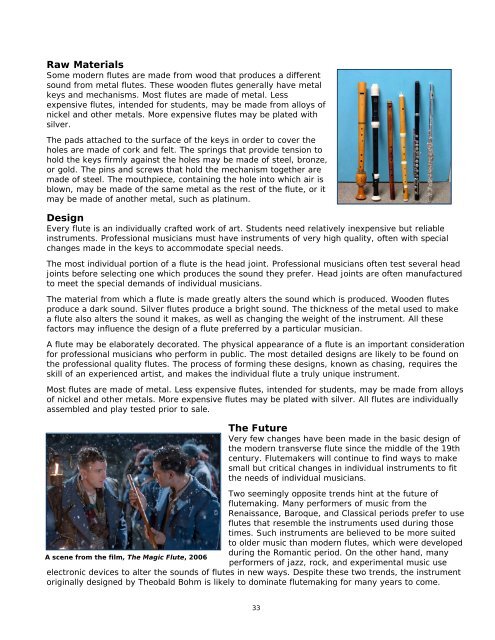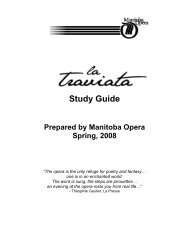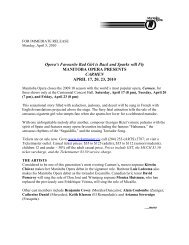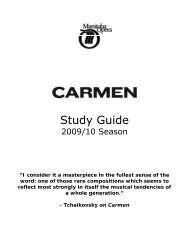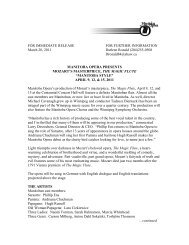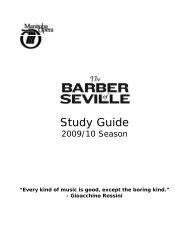The Magic Flute Study Guide - Manitoba Opera
The Magic Flute Study Guide - Manitoba Opera
The Magic Flute Study Guide - Manitoba Opera
Create successful ePaper yourself
Turn your PDF publications into a flip-book with our unique Google optimized e-Paper software.
Raw Materials<br />
Some modern flutes are made from wood that produces a different<br />
sound from metal flutes. <strong>The</strong>se wooden flutes generally have metal<br />
keys and mechanisms. Most flutes are made of metal. Less<br />
expensive flutes, intended for students, may be made from alloys of<br />
nickel and other metals. More expensive flutes may be plated with<br />
silver.<br />
<strong>The</strong> pads attached to the surface of the keys in order to cover the<br />
holes are made of cork and felt. <strong>The</strong> springs that provide tension to<br />
hold the keys firmly against the holes may be made of steel, bronze,<br />
or gold. <strong>The</strong> pins and screws that hold the mechanism together are<br />
made of steel. <strong>The</strong> mouthpiece, containing the hole into which air is<br />
blown, may be made of the same metal as the rest of the flute, or it<br />
may be made of another metal, such as platinum.<br />
Design<br />
Every flute is an individually crafted work of art. Students need relatively inexpensive but reliable<br />
instruments. Professional musicians must have instruments of very high quality, often with special<br />
changes made in the keys to accommodate special needs.<br />
<strong>The</strong> most individual portion of a flute is the head joint. Professional musicians often test several head<br />
joints before selecting one which produces the sound they prefer. Head joints are often manufactured<br />
to meet the special demands of individual musicians.<br />
<strong>The</strong> material from which a flute is made greatly alters the sound which is produced. Wooden flutes<br />
produce a dark sound. Silver flutes produce a bright sound. <strong>The</strong> thickness of the metal used to make<br />
a flute also alters the sound it makes, as well as changing the weight of the instrument. All these<br />
factors may influence the design of a flute preferred by a particular musician.<br />
A flute may be elaborately decorated. <strong>The</strong> physical appearance of a flute is an important consideration<br />
for professional musicians who perform in public. <strong>The</strong> most detailed designs are likely to be found on<br />
the professional quality flutes. <strong>The</strong> process of forming these designs, known as chasing, requires the<br />
skill of an experienced artist, and makes the individual flute a truly unique instrument.<br />
Most flutes are made of metal. Less expensive flutes, intended for students, may be made from alloys<br />
of nickel and other metals. More expensive flutes may be plated with silver. All flutes are individually<br />
assembled and play tested prior to sale.<br />
<strong>The</strong> Future<br />
Very few changes have been made in the basic design of<br />
the modern transverse flute since the middle of the 19th<br />
century. <strong>Flute</strong>makers will continue to find ways to make<br />
small but critical changes in individual instruments to fit<br />
the needs of individual musicians.<br />
Two seemingly opposite trends hint at the future of<br />
flutemaking. Many performers of music from the<br />
Renaissance, Baroque, and Classical periods prefer to use<br />
flutes that resemble the instruments used during those<br />
times. Such instruments are believed to be more suited<br />
to older music than modern flutes, which were developed<br />
during the Romantic period. On the other hand, many<br />
A scene from the film, <strong>The</strong> <strong>Magic</strong> <strong>Flute</strong>, 2006<br />
performers of jazz, rock, and experimental music use<br />
electronic devices to alter the sounds of flutes in new ways. Despite these two trends, the instrument<br />
originally designed by <strong>The</strong>obald Bohm is likely to dominate flutemaking for many years to come.<br />
33


